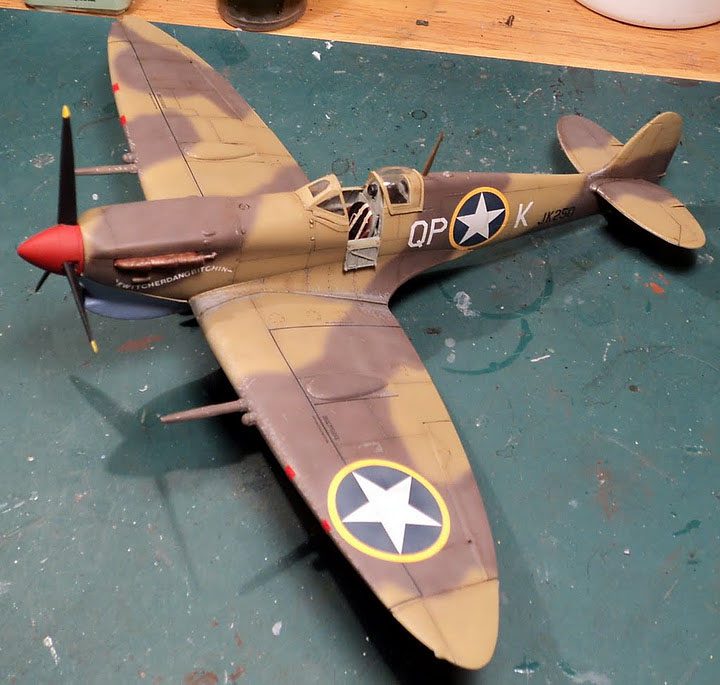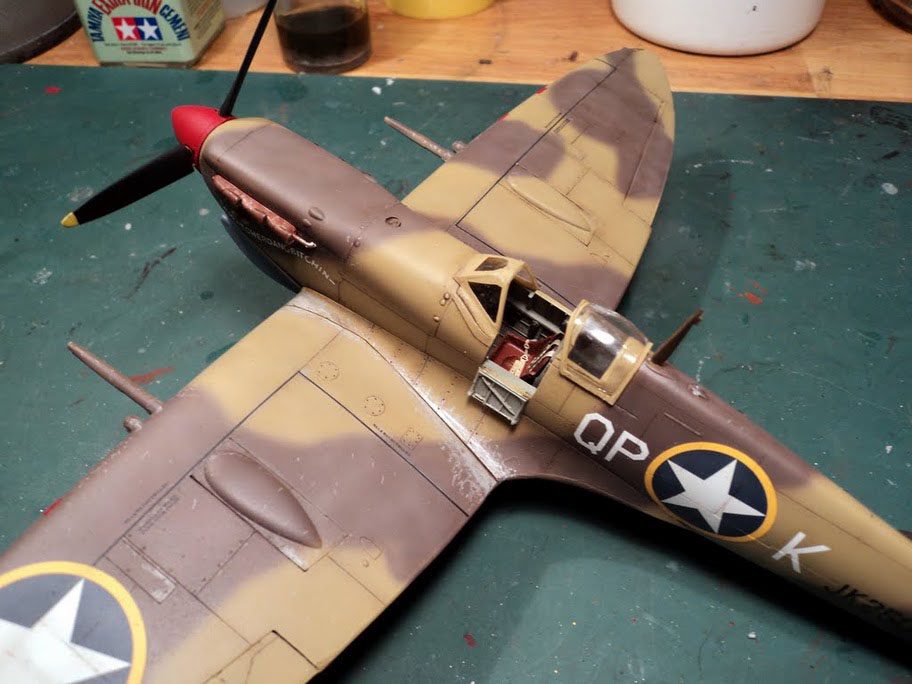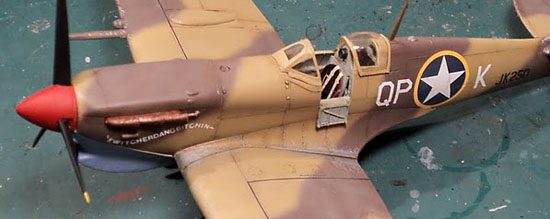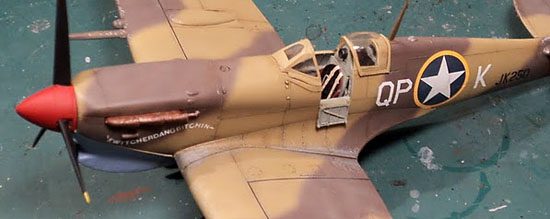I’ve always said I never met a Spitfire kit I didn’t like. However, I must admit that I was sorely tested building this kit.
While the short run pedigree shows when you first examine the parts, it’s a very “mainstream” short run casting. Parts quality is very good, with only some extra cleanup needed here and there. It’s a bit deceptive, in fact. The parts look great, and when parts look that good, you go into it thinking the build will be also.
I liked the cockpit layout, generally. The kit has two glue-in sidewalls that look very nice. I was actually a bit surprised at the level of detail. The casting and overall detail are good, though some odd omissions leave it a bit lacking in minor areas most kits get “right”.
The Spitfire cockpit is very distinctive, and can be quite complicated to get “right”. I think only Tamiya’s 1/32 scale offering comes close. But there are some parts to a Spitfire cockpit that I consider “fundamental”, meaning if you get those in, you’ve hit the obvious points.
One part is the radio channel selector, on the left cockpit wall. It’s fairly near the pilot door, and due to it’s higher position in the cockpit, is very prominent. It’s basically just a rectangle in 1/48 scale. Another part is the remote contactor box for the IFF transmitter. It’s on the right cockpit sidewall, and is very prominent, especially in an open cockpit build with the access door down. It is a rectangular box with a white instrument-type face in it. Even the most basic castings generally add some semblance of this. Yet both of these parts were missing. I found this quite odd, seeing as how so much of the rest of the cockpit was done so well.
Of course, scratch building these is not difficult. Still, given the care that was obviously put into the cockpit detailing, these and a few other key features absence is odd.
Overall though, it’s a very nice office representation. The “floorless” look is reasonably captured, as is the seat frame, support and armor.
Assembly was a bit fiddly. The control column is three parts- the main column, the spade grip, and the linkage rod. Careful test fitting and gluing is needed to get these delicate parts lined up correctly. (In fact, the instructions stress test fitting on every page, which is a great idea to reinforce.)
The seat assembly was also a bit fiddly. While the instructions show the parts going together in a single sequence, I found it worked best for me to mount the seat supports to the seat armor and let that dry, then add the assembly to the fuselage frame, and finally add the seat itself. Even then, the attachment points are a bit precarious, and a hidden blob of CA to make things stay in pace is probably not a bad idea.
The instrument panel is nicely cast. Though decals are provided to lay over the top of the painted IP, I chose to “dry-brush” with a silver Prismacolor pencil, and then use other Prismacolor pencils to pick out color here and there. I’ve been trying this method out on the last couple of builds and generally like it better than traditional dry brushing, as I feel it gives more control and the ability to make finer application of color than either dry-brushing or point-brush painting does.
After assembling the major parts of the cockpit, I used my silver Prismacolor to add some weathering and highlighting, and finished off with an oil wash to pop out detail.
And then came the process of closing up the fuselage.
Wow.
I’ve built all sorts of Spitfires, in 72nd, 48th, 32nd and even a 24th scale one. In 1/48 scale, I’ve built just about all of the mainstream kits, and a few of the oddballs.
This kit, I can say without reservation, is by far the worst fitting Spitfire I’ve ever built.
I was really disappointed. I know it’s short run. The instructions warn you to test fit. But it was absolutely so poor, nothing prepared me for this.
The problem starts with the way the cockpit is engineered. The kit has separate sidewalls. In theory, it’s a good idea. The sidewalls are nicely cast and detailed, and look good. And the various bulkhead pieces that are to be sandwiched between them look good, too.
However, when I actually went to close up the fuselage, with the cockpit parts fitted between, they simply did not fit. It was almost as if the two major bulkhead pieces- the one aft of the seat, and the one the IP was mounted on, were cast to the width of the interior fuselage without accounting for the sidewalls at all. It was no trivial matter- the resulting fuselage gap was fully an eight of an inch wide.
For the aft bulkhead, I finally had to resort to slicing out a section along the right sidewall to make room for the bulkhead, and then further sanding down the bulkhead to the point that it was almost ridiculous looking.
For the forward bulkhead parts, I simply sanded and sand, almost to the point of sanding them away entirely.
Only after this was I able to get the fuselage closed up to a semblance of what it should be. Copious amounts of Tamiya Extra Thin cement and clamps and rubber bands were applied to seal things up. After some initial sanding, an application of Mr. Surfacer 1000, and more sanding did things get to looking fairly normal. All of the sanding and squeezing did result in a slightly out of shape profile, though hopefully it will not be too obvious from most angles after painting.
The wings pieces were better in terms of fit. Initially I thought they were going to have issues also, but then I realized that the alignment pins were not aligned- so sanding those off fixed the problem. Some sanding of the mating surfaces was required, but after a liberal dose of Tamiya Extra Thin, and some clothespin clamps, the wings sanded down to a good, clean look, on the leading and trailing edges.
Alas, the calm I experienced with the wings was short-lived. It was time to mate the wings with the fuselage.
I’m not sure if the join was hampered by engineering, the hacking required to get the fuselage closed, my lack of skills in dealing with such issues, or a combination of the three. (I suspect the latter.) The fit at the leading edge was OK- one side was perfect, the other a small but manageable gap. The wing roots were a mixed bag, almost as if the edge was not quite straight. Except for a step at the trailing edge on the port wing, it was manageable with the use of plenty of Tamiya Extra Thin, and some shims of sheet styrene.
The fit of the undersides was another matter. This is an area that nearly every Spitfire kit has problems with. But this one, by far, was the worst I’ve seen. To start with, the interior parts extended down to far, and thus pushed the rear part of the wing and associated fuselage underside down a bit. Sanding was required along the length of the projecting cockpit parts, to the point that it begin to worry me that the structural integrity of the cockpit itself would be compromised. And it’s not that I had the parts mis-placed. The location of the parts is quite apparent during assembly. I think this was just a case of short-run engineering. I finally sanded it down to the point that I could use other techniques to fill the gaps along the trailing edge of the wing as they blend into the fuselage.
And even all of this still left a gap of 1-2 mm at the very aft portion of the join. That would require more shims, and the nicely cast detail there will pretty much be gone after the sanding. While it’s not hard to re-scribe panel lines, some of the other raised detail is extremely difficult to re-create.
With the wings on, and the initial gluing efforts dried, it was time to tackle the gaps.
Now these weren’t just gaps. They were big gaps. Gaps to the point that Michael Strahan would’ve done a double-take.
I decided the best approach would be to use stretched sprue from the kit. My reasoning was simple- the plastic from the sprue, coupled with some globs of Tamiya Extra Thin cement, would results in consistent plastic quality. The kit is made from a soft, carvable plastic. Not brittle at all.
I stretched out several strands of fairly thick segments. As I may have mentioned, these were not trivial gaps. It took sprue the thickness of a thick pencil lead to work. I cut up the pieces of sprue to work them around the angles and such. I literally blobbed on Tamiya Cement to soften the plastic, and using the side of a #11 blade, I “mushed” it into the gaps as much as possible to minimize the sanding I’d have to do later.
After allowing things to dry overnight, the sanding began. Along the trailing edges of the wing, where it joins the fuselage, things went OK there. It looks a tad thick, but it will be presentable.
Underneath the fuselage is a different story. Because of the complex shapes in that area, and sanding of the variety needed here will pretty much obliterate detail. Being a firm believer in the idea that no one actually looks at the underside of a model, I sanded away until most of the offending gaps, bumps and ridges were gone. I say “most of” simply because at some point I decided it was good enough and put it aside.
The tailplane tabs didn’t fit in the slots at all. Eventually I just cut the tabs off. The Vokes filter didn’t fit either. It had some small tabs supposed to fill the gap where it met the underside of the wing. But- you guessed it- the only way I could get it to fit was to sand those off. The radiator required work, as did the oil cooler. The landing gear actually fit in. I had to double-check that I didn’t do something wrong, they fit so well. The small piece that closed up the opening in the fuselage that allows a Seafire’s A-frame arrestor hook to fit in went in OK. There’s a step on one side, but at this point, I’m not sanding anymore. It is what it is.
Eventually, it all came together. With all the sanding done (or what I had done of it…), it wasn’t a bad looking Spitfire. In fact, it probably looks the best, shape and detail-wise, of any Mk. Vc I’ve seen.
But it’s a tough fight getting there.
The rest was anti-climatic. Put on the paint, then the decals, do some weathering. No drama there, thankfully.
In the end, it’s not a bad looking Spitfire, even though I bailed on some of the sanding. Just don’t look at those areas. 🙂
I think what gets me the most about this kit is the cost- it was around $40. I could have bought the Airfix Spitfire Mk. I, and the Mk. Vc, did a kit bash, and still spent less money. And the fit would have been much better. (Or picked up Tamiya’s Vb, and an Ultracast resin Vc wing, for not too much more money.)
It did stretch my modeling skills, so that was good. And I likely would have not been as disappointed had I read Brett Green’s account of the kit before I started. He provides a list that is spot-on, from my experience.
Oh well. Live and learn. Better to build a not-quite-so-good Spitfire than a quite good anything else, I say. 😉
And at least when I get to Special Hobbies Seafire III, which is sitting in the stash also, I’ll know what to do. it’s the same plastic!








Leave a Reply